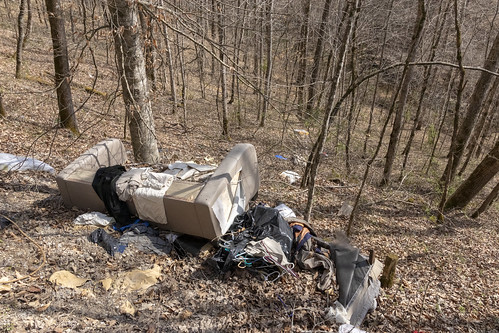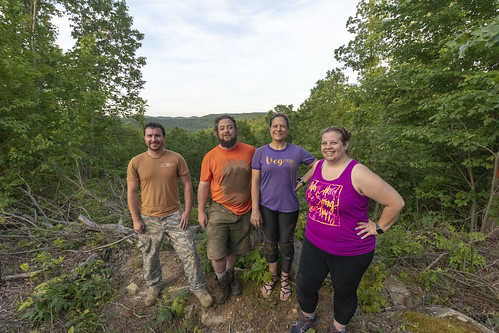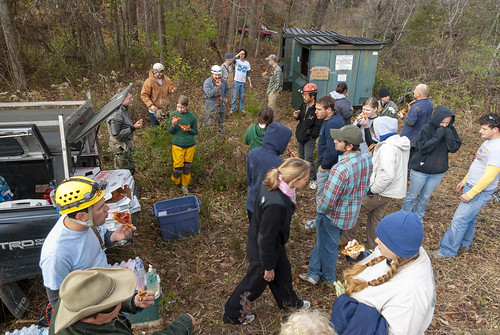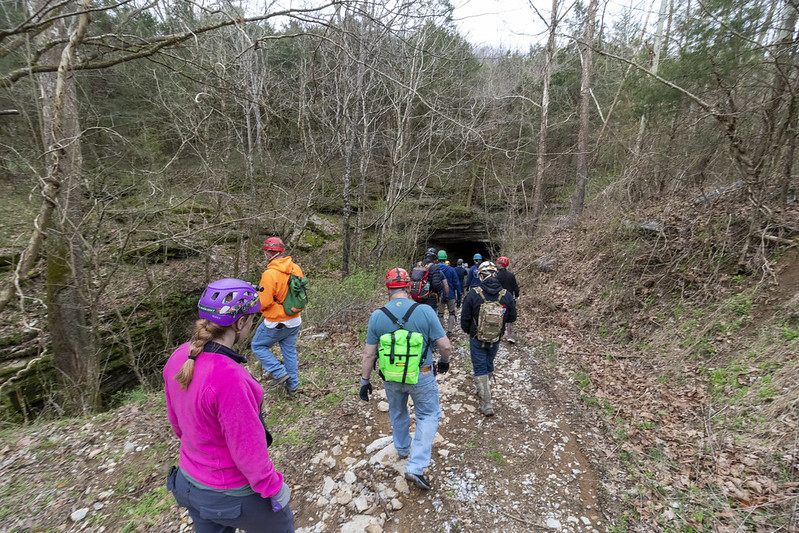How to do a Cleanup
 Stages of a cleanup
Stages of a cleanup- Identify an illegal dump site or graffiti ridden location
- Secure landowner permission
- Build your team
- Build partnerships
- Set a date
- Gather volunteers
- Resolve legal and logistic issues
- Contact the media
- Obtain supplies
- Execute the cleanup
- Conduct a post-cleanup analysis
Identify an illegal dump site or graffiti ridden location
It may be that you already know a place that needs to be cleaned. If you don't talk with local officials and folks who spend time outside. Someone can point you to a place in need.Knowing where to clean is only part of the process though. You need to know whose property you would be working on. If you're in Tennessee, you can use the Tax Assessor webpage to explore who owns what. Alternately your friendly neighborhood GIS professional can help you get at this information.
Secure landowner permission
 You'll want to reach out to the landowner early on in planning to make sure they are fine with you proceeding. Keeping the landowner involved at every step is a good idea as well. Many landowners will be out there with you the day of the cleanup. You're doing them a favor. Some landowners may be concerned with liability. Look in the section titled Resolve legal and logistic issues for information on how to deal with this.
You'll want to reach out to the landowner early on in planning to make sure they are fine with you proceeding. Keeping the landowner involved at every step is a good idea as well. Many landowners will be out there with you the day of the cleanup. You're doing them a favor. Some landowners may be concerned with liability. Look in the section titled Resolve legal and logistic issues for information on how to deal with this.Be sure to get their permission in writing. Chances are it isn't necessary, but there seem to be a lot of people out there who flip flop. You want to make sure you're working with a stable predictable partner before proceeding.
Build your team
 Suggested Cleanup Team
Suggested Cleanup Team- Chair
- Communications
- Safety
- Technical
While it doesn't have to fit the above form exactly, each of the appointed committee members play an important role.
The chair serves as an executive who leads meetings, makes duty assignments, and provides energy and motivation. Other team members may hit snags with their jobs, they should communicate issues with the chair and the chair should work to resolve issues quickly.
Communications is the one of the most important committee members. They keep track of meeting minutes, keep people informed of their action items and jobs, and manage contact with any external groups as defined by the team and chair.
Safety's job is to make sure all precautions are met prior to the cleanup. This includes checking people in, making sure liability waivers are signed, observing the cleanup and preventing people from being hurt. This person may have to tell people to stop doing things which are unsafe so choosing someone with a commanding personality is important.
Technical team members are responsible for any rigging, implementation of haul lines, or any other technical engineering that needs to be done to execute the cleanup. Not every cleanup needs technical members.
Build partnerships
 You can't do a cleanup alone. You'll need a team of people close to you that you trust to get things done quickly and accurately. Ideally these people come from different walks of life and are able to bring the diverse skills necessary to successfully execute a cleanup.
You can't do a cleanup alone. You'll need a team of people close to you that you trust to get things done quickly and accurately. Ideally these people come from different walks of life and are able to bring the diverse skills necessary to successfully execute a cleanup.Partnerships may be the organizations your team members belong to, or who they have good working relationships with. Ideally you'll want partnerships in local government at a few levels, state government in conservation organizations, NGOs whose mission overlaps with yours, and other community volunteer organizations that can provide support and manpower.
Organizationally local governments can all be quite different, so there is no catch all for who you need to work with. You'll need to know someone who can help you haul off and dispose of the trash and tires. Some governments have clean commissions, all governments have solid waste departments. Sometimes you'll want to talk to the mayor yourself, other times you'll want to deal with lower ranking officials. Generally when governments learn you're doing a cleanup they'll bend over backwards to assist you. Everyone wants a cleaner more beautiful landscape, especially those seeking re-election.
Every state has a water resources department. In my experience they are always willing to throw their support behind a cleanup since illegal dumps affect water quality. Other state level organizations which may be relevant to at least talk to would be division of natural resources or whatever state fishery and wildlife exists.
NGOs, or non-government organizations, are specialized in their approach, mission, and values. Lots of conservation NGOs love to throw their weight behind a good cleanup. It's likely you can partner with several of these organizations for increased effectiveness. By no means is this a complete list, but I've had good luck working with these organizations in the past:
The Nature Conservancy
The Sierra Club
Boy Scouts of America
Community volunteer organizations worth reaching out to could include student organizations at your local college. They often require a number of volunteer hours yearly in order to maintain their charter. Fraternities, sororities, departmental clubs, and professional organizations are all looking for volunteer opportunities. Local hiking groups, local churches, the Rotary Club, the Chamber of Commerce, and other similar organizations are all worth talking to about partnership opportunities or identifying other partners and volunteers for your cleanup.
As a final note, if one of your organizations has 501(c)3 tax free status, you'll want to take advantage of them purchasing supplies. You'll want to be able to have them take earmarked donations and get them to purchase supplies later.
Set a date
The most intimidating part of the process is setting a date. You may be inclined to overthink this - do not. Here's what you need to consider and here's how you should proceed.Cleanups are best in cold weather. Late Fall, Winter, early Spring are ideal times since vegetation, snakes, ticks, insects, and poison ivy will be less of a concern. Vegetation is the most notable problem with cleanups since plants will envelope trash making it difficult to impossible to remove, and also hiding it.
You'll want to schedule two dates for a cleanup. A primary date, and a backup. Weather happens and we have no control over it. A backup date gives you some stability towards executing the cleanup in the event of rain, snow, or some other freak weather event.
Gather volunteers
 Your partners should help you with this process. Ideally they each have their own unique network of volunteers that they can reach out to. Look back at who your partners are and see how they can each best build a pool of reliable volunteers.
Your partners should help you with this process. Ideally they each have their own unique network of volunteers that they can reach out to. Look back at who your partners are and see how they can each best build a pool of reliable volunteers.Facebook is a good tool for building public awareness and momentum for a cleanup. Create a public event page and invite all your friends who would be interested and would be able to participate. Have your partners do the same.
Resolve legal and logistic issues
 Everyone's concerned about liability. Know your state's liability laws. This may mean you consult with a lawyer. If you do, make sure that they know this is for the purpose of making the community a better place and try to save yourself a legal fee.
Everyone's concerned about liability. Know your state's liability laws. This may mean you consult with a lawyer. If you do, make sure that they know this is for the purpose of making the community a better place and try to save yourself a legal fee.Your volunteers will need to sign liability waivers, and your landowner will want the best legal protection in place to protect them from litigation should something go awry. To this end, you should think about having a "Safety officer" for the cleanup. Whatever this person says, goes. You'll need to make decisions to mitigate any legal problems up front. For example if children are at a cleanup, do not put them on a steep hill with metal and glass. Kids are good for working the road near the cleanup, unless it's a busy road.
Contact the county roads department early in your planning process and request them to put up signs the before the cleanup encouraging automobile traffic to slow down.
You'll need to plan for a prepare the landscape for your cleanup. If there are steep hills or cliffs then you'll need rope and the people who know how to best use it. If there is lots of vegetation (even dead) then have chainsaws and folks who know how to use it. If there is graffiti, spot clean it in a few places to see what works and what doesn't. Sometimes this step requires some creativity, so this is a good time to bring your team together to creatively solve problems in advance of the cleanup. Try to anticipate problems and address each one individually. Talk through solutions because one person doesn't have all the answers.
Make sure you have solved where the trash is going, who is taking it there, and how they are taking it there. Make sure you know where the tires are going. Often household trash and furniture / construction materials need to be separated. Have plans for this. If you are using earmarked money or working with a grant make sure you've addressed all the needs and concerns of whatever is funding you.
Contact the media
 This step may sound self-aggrandizing, but I feel it's one of the most important steps. If we are to make permanent change in the world then we do so by education. Educating people and shifting their values is arguably the most important thing a cleanup does since you're potentially shifting public opinion on matters of conservation. Most people agree that we should keep the land free of trash and graffiti. If they are on the fence and see overwhelming public support for it, they are likely to shift their attitudes
This step may sound self-aggrandizing, but I feel it's one of the most important steps. If we are to make permanent change in the world then we do so by education. Educating people and shifting their values is arguably the most important thing a cleanup does since you're potentially shifting public opinion on matters of conservation. Most people agree that we should keep the land free of trash and graffiti. If they are on the fence and see overwhelming public support for it, they are likely to shift their attitudesMake sure your local media representatives know the date, time, and location of your cleanup. Have someone appointed to deal with them directly who can eloquently explain the importance of doing cleanups. Provide them with necessary media, like before and after photos, and photos of the cleanup process.
Obtain supplies
Inventory in advance of the cleanup the tools you need and who will be bringing them. If you're a 501(c)3 tax except organization, or you're partners with one, get them to make the purchases.Every cleanup needs: gardening gloves, leather work gloves, loppers, hand shears, drinking water, and snacks.
At larger cleanups you may want to serve lunch. Maybe you can find a local pizza place that will cut you a deal? Maybe a local restaurant or caterer will want their name on your sponsors? Lunch can usually be worked out if you invest some time looking. Sometimes a partner may already have a plan for this.
Larger cleanups will also require a more complex assortment of tools. Rope, ropework tools, chainsaws, shovels, pickaxes, wenches, and haul systems may be needed. Tables and chairs for eating and planning also may be required.
Execute the cleanup
The day of the cleanup comes. Like anything important, prepare as much as you can in the days before, and arrive there early. Someone's job should be making sure volunteers are signed in and have all their liability forms in place. Someone should address the group and explain what the objective is, introduce the safety officer and explain their position, as well as set times for breaks, lunches, and finishing. They should communicate safety and logistical issues to the group to prepare them for the day's work. The person dealing with the media should be taking photographs. It is a good idea to make this person in charge of communicating with the group because it is likely they will get spread out throughout the course of the cleanup. They should have a backpack with gloves, trash bags, and small tools because people will be needing these throughout the day.Stage trash alongside roads for quick pickup at the end of the day. Designate a team of people to do a sweep at the end of the cleanup to make sure no one leaves any personal belongings, tools, or trash behind.
Conduct a post-cleanup analysis
As a final step, set a meeting within a few days after you've completed the cleanup that should be attended by your team and maybe a few of the volunteers. You'll want to discuss what worked, what didn't work, and what could be improved. Write it all down and keep that record somewhere. Sometimes the space between cleanups can be a while and it's easy to forget what we've learned along the way.Last, but certainly not least, Maureen Handler made available some planning spreadsheets used by the SERA Karst Task Force.
Comments